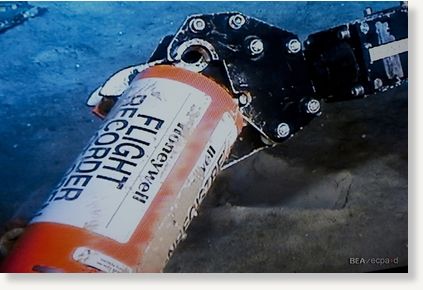
France's air accident investigation agency BEA said a search by a submarine probing 3,900 meters (12,800 feet) below the ocean's surface located and recovered the unit Sunday morning. The unit is now aboard the Ile de Sein, a ship that's helping conduct the probe, the statement said.
The statement also included photos of the recorder - a red cylinder partially buried in sand on the sea floor. Judging from the photos, the unit appeared to be in good condition.
Still, BEA officials have warned that the recordings may yet prove unusable, considering the pressure they were subjected to for nearly two years.
"We can't say in advance that we're going to be able to read it until it's been opened," a BEA spokeswoman told The Associated Press in a telephone interview. She did not give her name in accordance with her agency's policy.
Last month, the agency said the undersea search had identified the "chassis" that had held the recorder, but the memory unit was still missing. Detached from the chassis, the memory unit was found nearby, the spokeswoman said.
The flight data recorder stores technical data from the flight. Another so-called "black box" records cockpit conversations. The second black box has not yet been found, but the submarine probes were continuing, the spokeswoman said.
Investigators hope Sunday's remarkable discovery will allow them to determine what caused the June 1, 2009 crash of Flight 447 from Rio de Janeiro, Brazil, to the French capital, Paris. The aircraft slammed into the Atlantic northeast of Brazil after running into an intense high-altitude thunderstorm.
Automatic messages sent by the Airbus 330's computers showed it was receiving false air speed readings from sensors known as pitot tubes. Investigators have said the crash was likely caused by a series of problems, and not just sensor error.
The crash site was so remote and in such a deep area of the Atlantic that two previous undersea operations failed to turn up the bulk of the wreckage. The latest search - the fourth - was targeting an area of about 3,900 square miles (10,000 square kilometers), several hundred miles off Brazil's northeastern coast.
Searchers were using up to three autonomous underwater search vehicles, each of which can stay underwater for up to 20 hours while using sonar to scan a mountainous area known as the Mid-Ocean Ridge. Researchers download the data, and a vehicle with a high resolution camera is sent to check out an area if scientists see evidence of debris.
In early April, French officials said the operation had succeeded in finding most of the Airbus jet, including its motors. Bodies of some of the victims were also discovered.
Determining the cause of the crash took on new importance in March, when a French judge filed preliminary manslaughter charges against Air France and planemaker Airbus.
Air France and Airbus are financing the estimated $12.5 million cost of the latest search effort, but the French government is to fund the retrieval effort. About $28 million has already been spent on the three previous searches for the jet's wreckage.
Experts have said that without retrieving the voice and data recorders there would be almost no chance of determining what caused the crash - the worst disaster in Air France's history.



Reader Comments
to our Newsletter